sensor Lexus CT200h 2011 Owner's Manual (in English)
[x] Cancel search | Manufacturer: LEXUS, Model Year: 2011, Model line: CT200h, Model: Lexus CT200h 2011Pages: 696
Page 4 of 696

TABLE OF CONTENTSIndex
4
CT200h_EE (OM76041E)
2-4. Using other driving systems
Cruise control ..................... 248
Dynamic radar cruise
control .............................. 252
Lexus parking assist-sensor 269
Rear view monitor system.. 275
Driving assist systems ........ 285
Hill-start assist control ....... 290
PCS (Pre-Crash Safety
system) ............................. 292
2-5. Driving information
Cargo and luggage ............. 301
Winter driving tips ............. 304
Trailer towing..................... 3083-1. Using the air conditioning sys-
tem and defogger
Automatic air conditioning
system .............................. 312
Rear window and outside
rear view mirror defogger
switch ............................... 323
Windshield wiper de-icer ... 324
3-2. Using the audio system
Audio system types ............ 325
Using the radio ................... 329
Using the CD player........... 335
Playing MP3 and WMA
discs.................................. 344
Operating an iPod............... 353
Operating a USB memory .. 364
Optimal use of the audio
system .............................. 373
Using the AUX port ........... 376
Using the steering wheel
audio switches .................. 377
3Interior features
Page 11 of 696
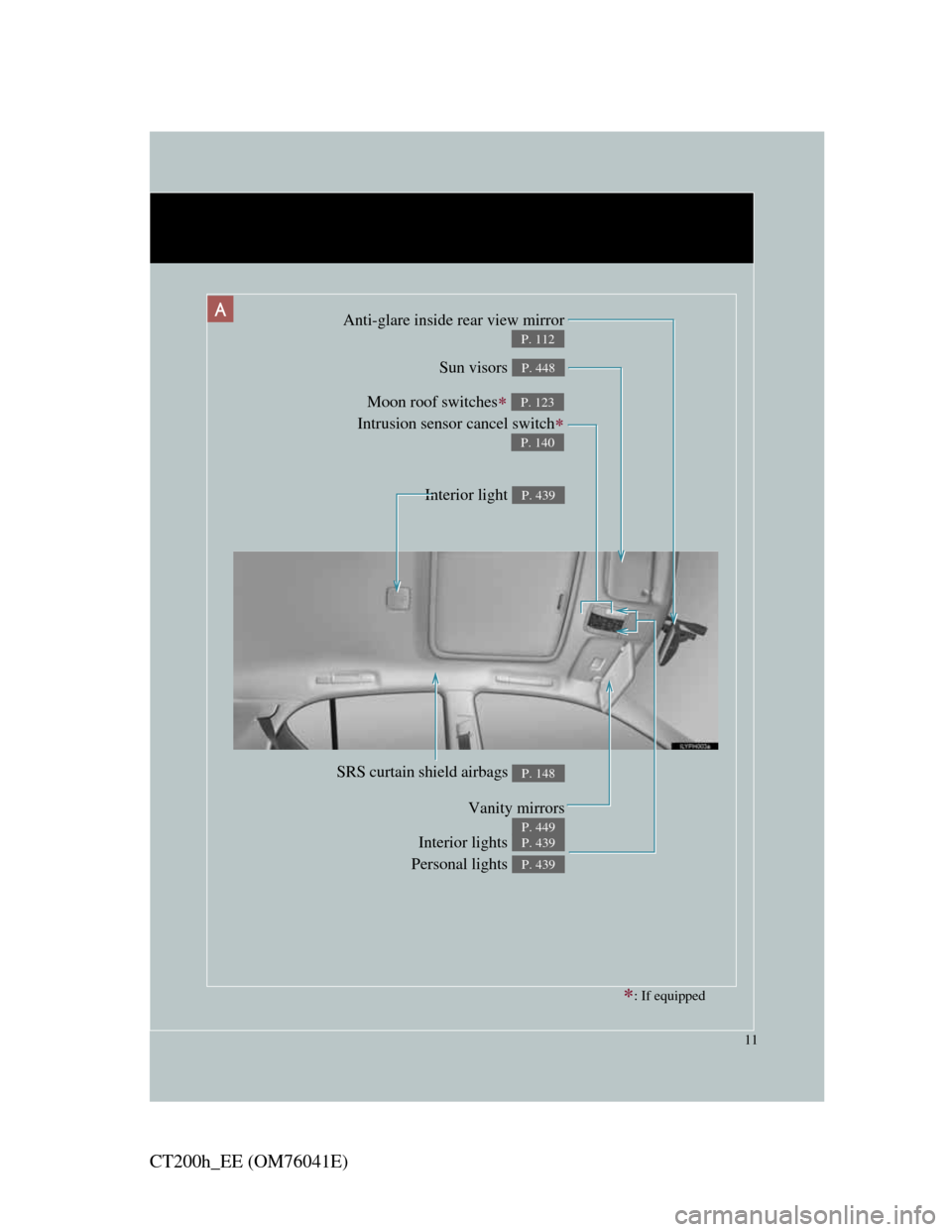
11
CT200h_EE (OM76041E)
Anti-glare inside rear view mirror
P. 112
Sun visors P. 448
SRS curtain shield airbags P. 148
Interior lights
Personal lights P. 439
P. 439
Moon roof switches
Intrusion sensor cancel switch
P. 123
P. 140
Vanity mirrors
P. 449
Interior light P. 439
A
: If equipped
Page 19 of 696
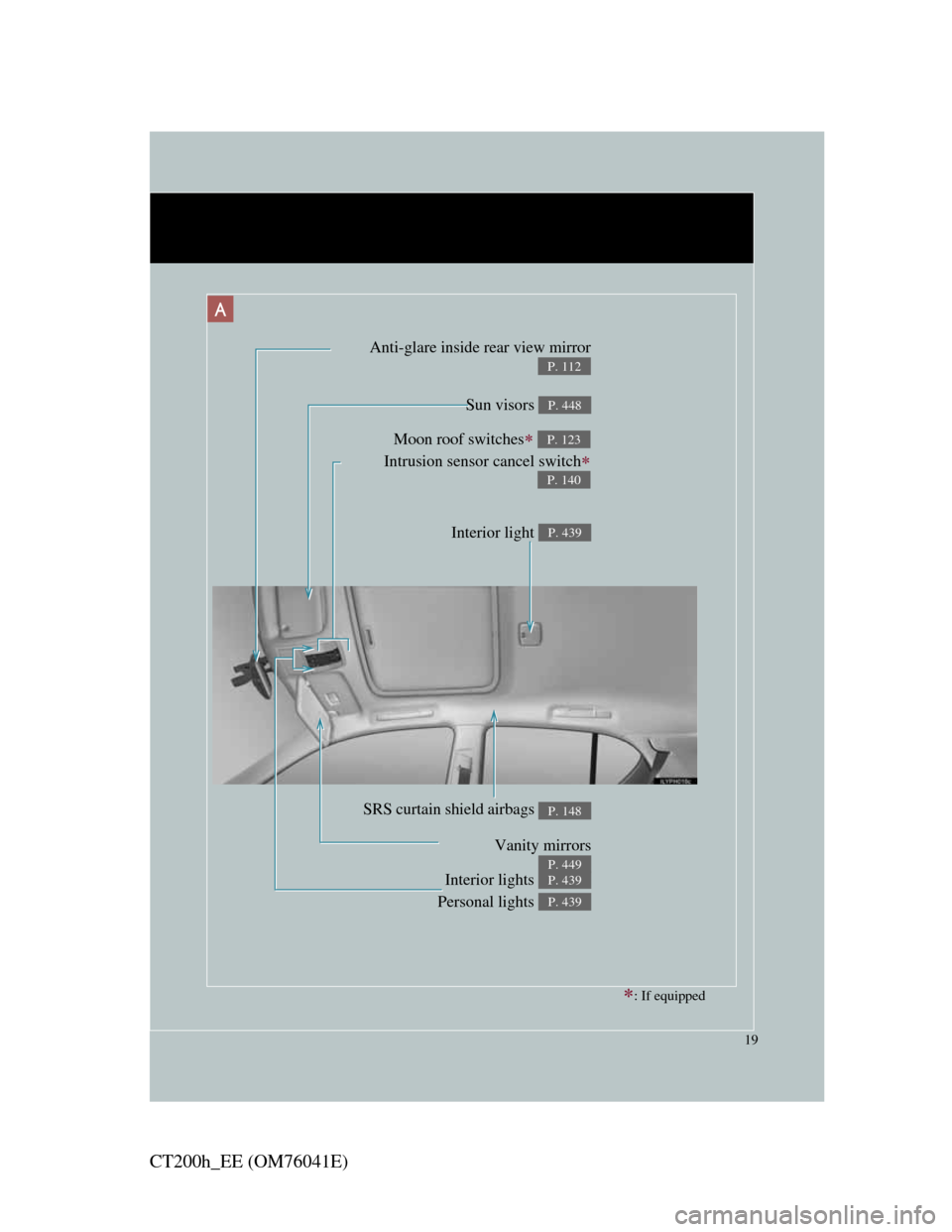
19
CT200h_EE (OM76041E)
Anti-glare inside rear view mirror
P. 112
Sun visors P. 448
SRS curtain shield airbags P. 148
Interior lights
Personal lights P. 439
P. 439
Moon roof switches
Intrusion sensor cancel switch
P. 123
P. 140
Vanity mirrors
P. 449
: If equipped
Interior light P. 439
A
Page 24 of 696
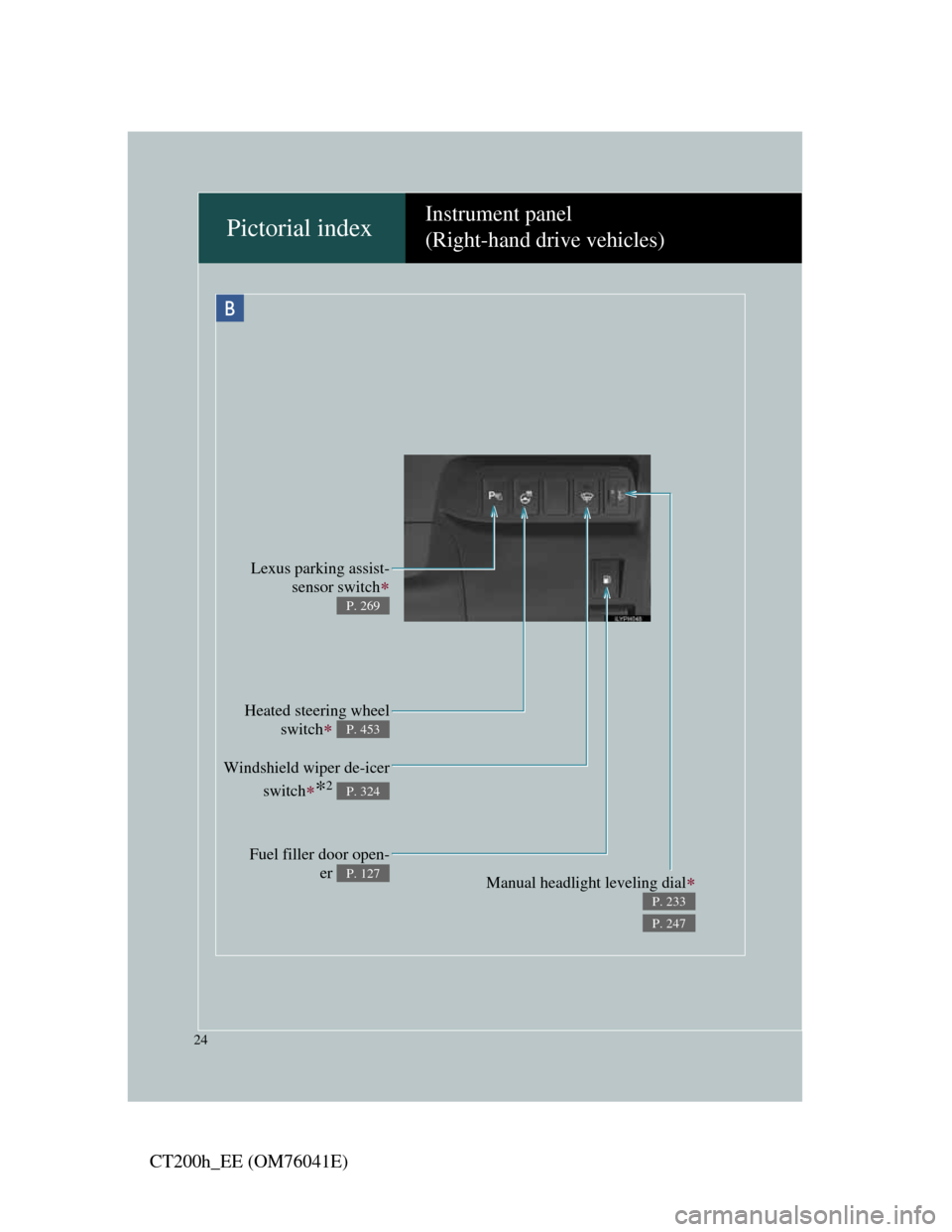
24
CT200h_EE (OM76041E)
Pictorial index
B
Instrument panel
(Right-hand drive vehicles)
Windshield wiper de-icer
switch
*2 P. 324
Fuel filler door open-
er
P. 127
Heated steering wheel
switch
P. 453
Lexus parking assist-
sensor switch
P. 269
Manual headlight leveling dial
P. 233
P. 247
Page 40 of 696
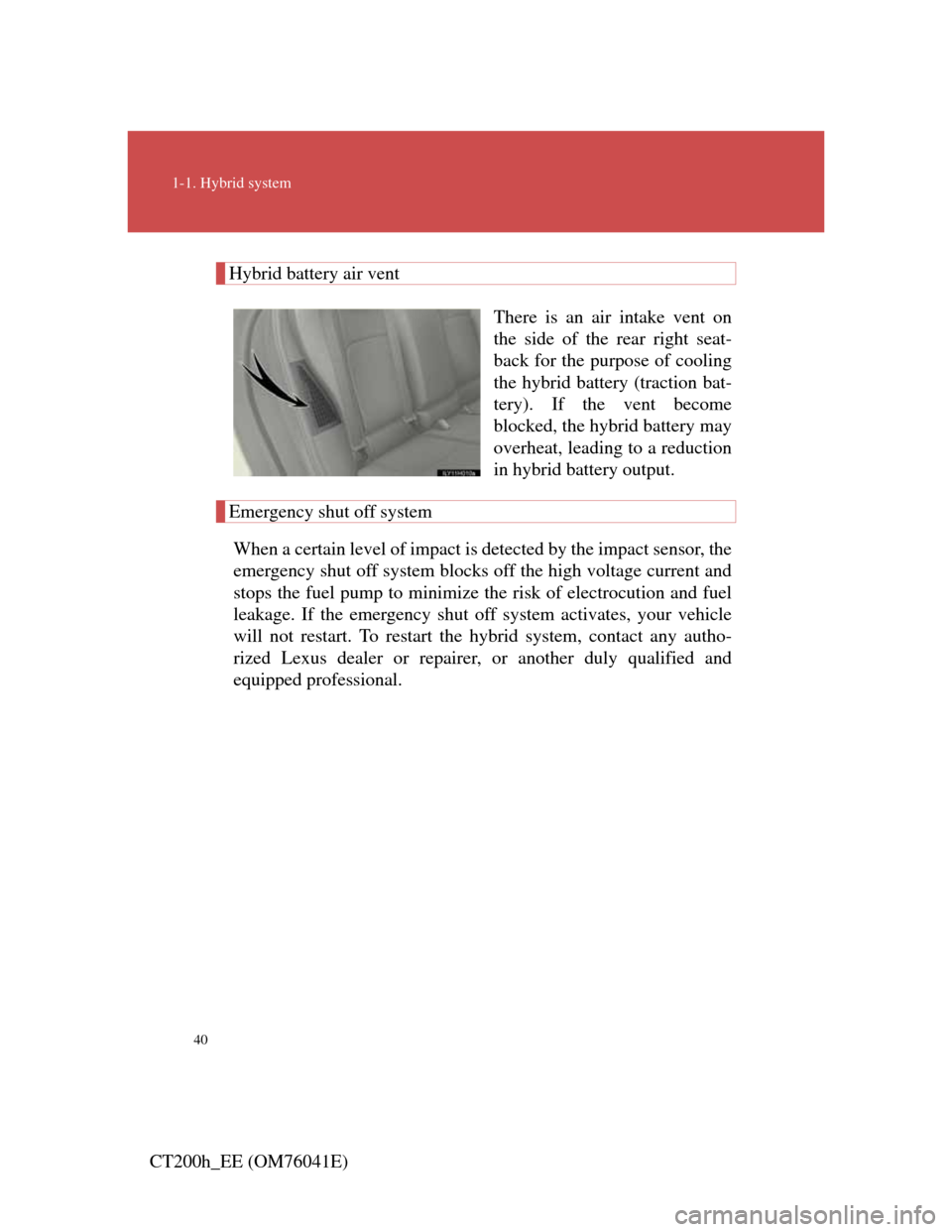
40
1-1. Hybrid system
CT200h_EE (OM76041E)
Hybrid battery air vent
There is an air intake vent on
the side of the rear right seat-
back for the purpose of cooling
the hybrid battery (traction bat-
tery). If the vent become
blocked, the hybrid battery may
overheat, leading to a reduction
in hybrid battery output.
Emergency shut off system
When a certain level of impact is detected by the impact sensor, the
emergency shut off system blocks off the high voltage current and
stops the fuel pump to minimize the risk of electrocution and fuel
leakage. If the emergency shut off system activates, your vehicle
will not restart. To restart the hybrid system, contact any autho-
rized Lexus dealer or repairer, or another duly qualified and
equipped professional.
Page 53 of 696
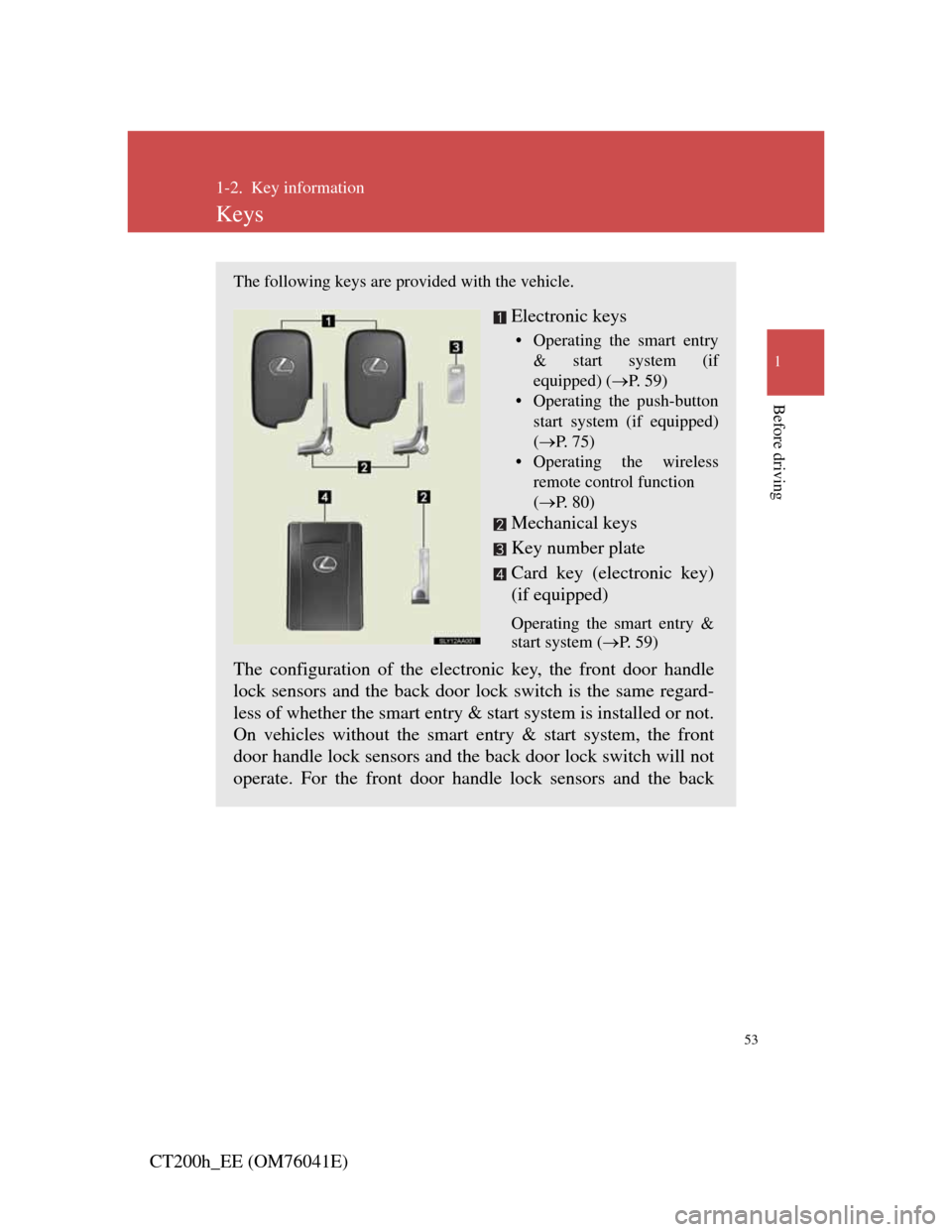
53
1
Before driving
CT200h_EE (OM76041E)
1-2. Key information
Keys
The following keys are provided with the vehicle.
Electronic keys
• Operating the smart entry
& start system (if
equipped) (P. 5 9 )
• Operating the push-button
start system (if equipped)
(P. 7 5 )
• Operating the wireless
remote control function
(P. 8 0 )
Mechanical keys
Key number plate
Card key (electronic key)
(if equipped)
Operating the smart entry &
start system (P. 5 9 )
The configuration of the electronic key, the front door handle
lock sensors and the back door lock switch is the same regard-
less of whether the smart entry & start system is installed or not.
On vehicles without the smart entry & start system, the front
door handle lock sensors and the back door lock switch will not
operate. For the front door handle lock sensors and the back
Page 60 of 696
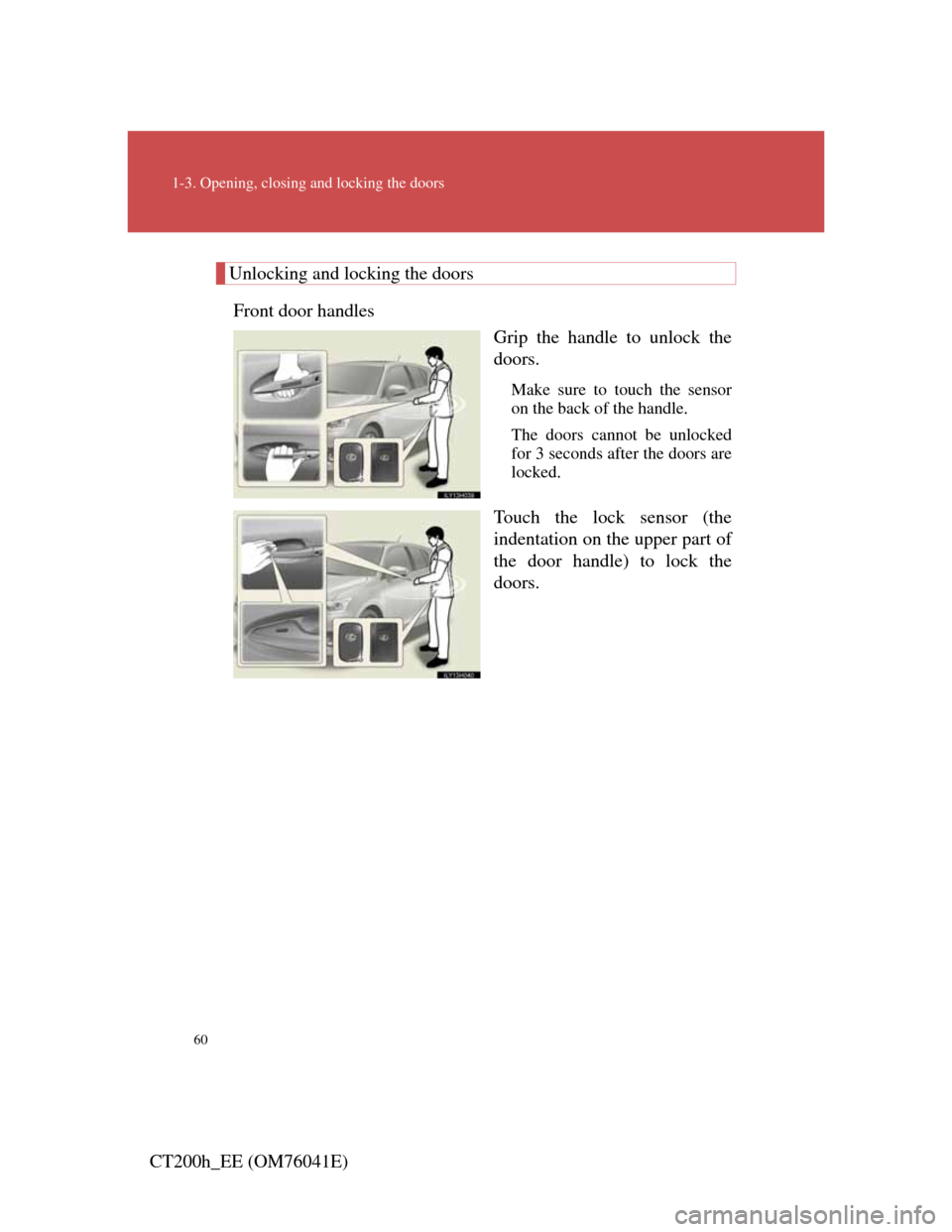
60
1-3. Opening, closing and locking the doors
CT200h_EE (OM76041E)
Unlocking and locking the doors
Front door handles
Grip the handle to unlock the
doors.
Make sure to touch the sensor
on the back of the handle.
The doors cannot be unlocked
for 3 seconds after the doors are
locked.
Touch the lock sensor (the
indentation on the upper part of
the door handle) to lock the
doors.
Page 63 of 696
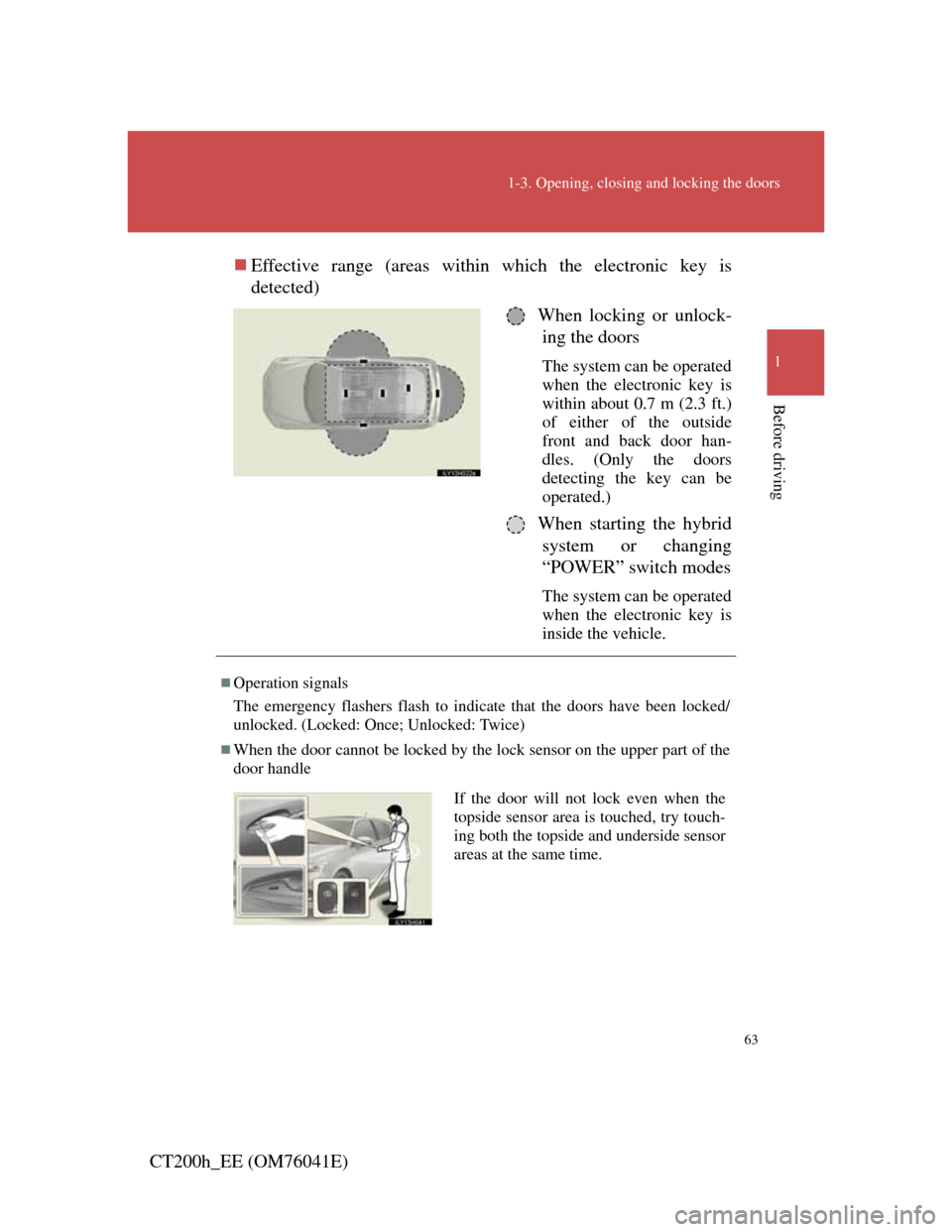
63
1-3. Opening, closing and locking the doors
1
Before driving
CT200h_EE (OM76041E)Effective range (areas within which the electronic key is
detected)
When locking or unlock-
ing the doors
The system can be operated
when the electronic key is
within about 0.7 m (2.3 ft.)
of either of the outside
front and back door han-
dles. (Only the doors
detecting the key can be
operated.)
When starting the hybrid
system or changing
“POWER” switch modes
The system can be operated
when the electronic key is
inside the vehicle.
Operation signals
The emergency flashers flash to indicate that the doors have been locked/
unlocked. (Locked: Once; Unlocked: Twice)
When the door cannot be locked by the lock sensor on the upper part of the
door handle
If the door will not lock even when the
topside sensor area is touched, try touch-
ing both the topside and underside sensor
areas at the same time.
Page 66 of 696

66
1-3. Opening, closing and locking the doors
CT200h_EE (OM76041E)
Note for locking the doors
Touching the door lock sensor while wearing gloves may delay or pre-
vent lock operation. Remove the gloves and touch the lock sensor again.
If the door handle becomes wet while the electronic key is within the
effective range, the door may lock and unlock repeatedly. Place the key
in a position 2 m (6 ft.) or more separate from the vehicle while the vehi-
cle is being washed. (Take care to ensure that the key is not stolen.)
If the electronic key is inside the vehicle and a door handle becomes wet
during a car wash, a message may be shown on the multi-information
display and a buzzer will sound outside the vehicle. To turn off the
alarm, lock all the doors.
The lock sensor may not work properly if it comes into contact with ice,
snow, mud, etc. Clean the lock sensor and attempt to operate it again, or
use the lock sensor on the lower part of the door handle.
Fingernails may scrape against the door during operation of the door
handle. Be careful not to injure fingernails or damage the surface of the
door.
Page 67 of 696

67
1-3. Opening, closing and locking the doors
1
Before driving
CT200h_EE (OM76041E)
Note for the unlocking function
A sudden approach to the effective range or door handle may prevent the
doors from being unlocked. In this case, return the door handle to the
original position and check that the doors unlock before pulling the door
handle again.
Gripping the door handle when wearing a glove may not unlock the
door. Remove the gloves and touch the sensor on the back of the handle
again.
If the door handle becomes wet while the electronic key is within the
effective range, the door may lock and unlock repeatedly. Place the key
in a position 2 m (6 ft.) or more separate from the vehicle while the vehi-
cle is being washed. (Take care to ensure that the key is not stolen.)
If there is another electronic key in the detection area, it may take
slightly longer to unlock the doors after the door handle is gripped.
Fingernails may scrape against the door during operation of the door
handle. Be careful not to injure fingernails or damage the surface of the
door.
When the vehicle is not driven for extended periods
To prevent theft of the vehicle, do not leave the electronic key within 2 m
(6 ft.) of the vehicle.
The smart entry & start system can be deactivated in advance. (P. 655)
Alarm
Using the smart entry & start system to lock the doors will set the alarm sys-
tem. (P. 138)
To operate the system properly
Make sure to carry the electronic key when operating the system. Do not get
the electronic key too close to the vehicle when operating the system from
the outside of the vehicle.
Depending on the position and holding condition of the electronic key, the
key may not be detected correctly and the system may not operate properly.
(The alarm may go off accidentally, or the door lock prevention may not
operate.)